Jade plants are among the most popular succulents having a forgiving nature.
Jade plants are also called friendship plant or money plant according to the University of Wisconsin.
The correct botanical name for this houseplant is Crassula ovata.
People prefer growing jade plants at home because they are easy to maintain, and their small, fleshy oval leaves are visually appealing.
Just like they are easy to care for, jade plants can also be grown effortlessly from stem or leaf cuttings.
Below are some methods to multiply your Jade plant and expand your collection.
Table of Contents
How to Propagate a Jade Plant?
You can propagate Jade plants using stem, leaf cuttings, or root divisions. For stem cutting propagation, plant the tips of the healthy stems in soil or water. For leaf cutting propagation, plant the healthy leaves into a moist potting mix. For root division, split the entire plant and replant them separately.

How to Propagate a Jade Plant?
Materials Essential for Propagating Jade Plant
Jade plants are easy to propagate if you have the right equipment and know the right techniques to take the cuttings.
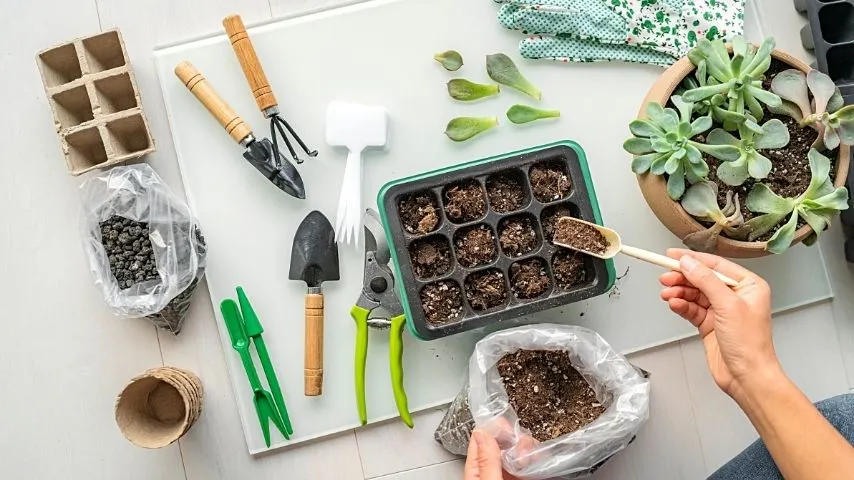
Prepare the materials you will be needing for propagating your Jade Plant
Be sure you have all the materials you’ll need before getting started with the process:
- Well-grown Jade Plant
- Sharp knife, scissors, or pruning shears
- 4-inch clean pots
- Cactus soil or succulent potting mix
- Rooting hormone
- Alcohol or bleach
- Water
3 Methods to Propagating a Jade Plant
The stem cutting method is the quickest and easiest way to propagate a Jade Plant.
Although it can also be done using a leaf, the process is preferably slower than stem cutting.
1. By Stem Cuttings
Below are some steps to take stem cuttings.
1. Disinfect the scissors with diluted alcohol or bleach. Disinfected scissors will not allow any bacteria or debris to contaminate your freshly cut stems.
2. Choose healthy stems from the plant to cut as these are essential for the growth of the new plant. For every planter, choose 3 – 5 stems.
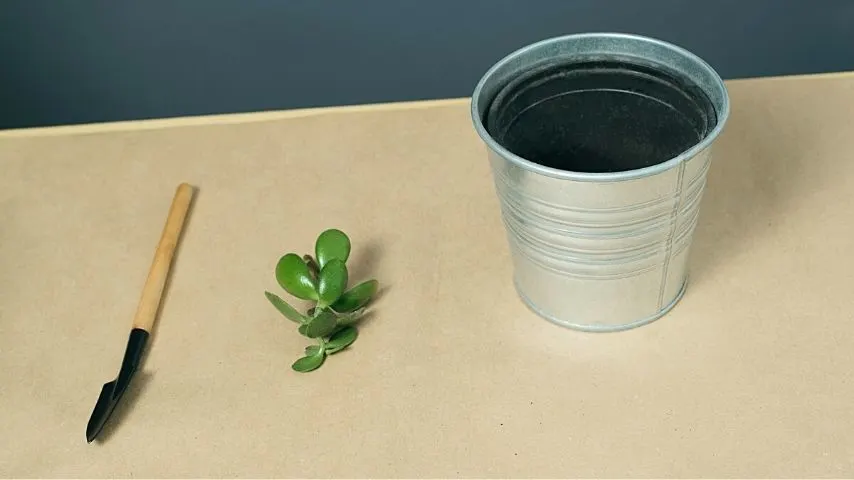
Choose healthy 3-5 healthy stems from your mother Jade plant
3. Remove the stem’s tip, which is approximately 3 – 4 inches long. Now, remove all the leaves present on the stem, leaving the leaf at the stem’s tip.
If you don’t have many stems on the plant, take a single stem and take multiple cuttings from it.
However, cut in a way that each cutting has some portion of the plant and a leaf to propagate it correctly. Put these cuttings on a clean surface.
4. Cut the base of every stem cutting, aiming to cut directly below a leaf node if you can. Your cuttings should be 2-3 inches in length.
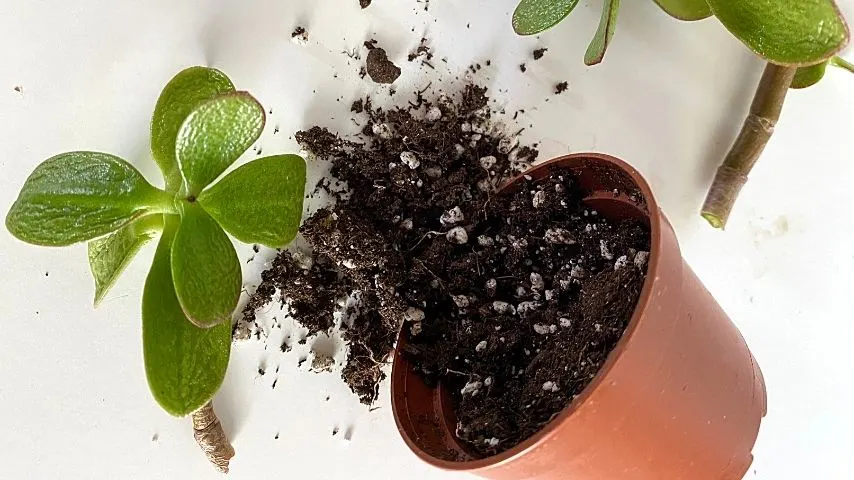
Cut the base of each Jade plant stem cutting below a leaf node
5. Keep the stem cuttings in any warm place for a week or two, making their ends callous. Callous ends prevent diseases and bacteria from entering and damaging the stem.
6. Dip each end of the stem into the rooting hormone. This is optional; however, it helps beginners propagate plants successfully.
2. By Leaf Cuttings
The following steps will help you take the leaf cuttings and propagate your Jade Plant easily:
1. Choose a healthy leaf to cut. A young, medium-sized leaf is more suitable and adjusts easily when removed from the stem than an older leaf.
2. Using the scissors, remove the leaf from the stem. Snip the cut flush with its stem.
3. Keep the leaf in a dry area, making sure to avoid moisture as much as possible. The wounds on the leaf should dry and become callous to avoid diseases and rot. The drying process also allows roots to poke through the dried wound.
4. Within a few weeks, tiny white roots will start to bulge out from the wound. Once you see these roots, you will notice the leaf shrinking and shriveling up. This shows that your roots are gaining energy and moisture from the leaf to produce roots.
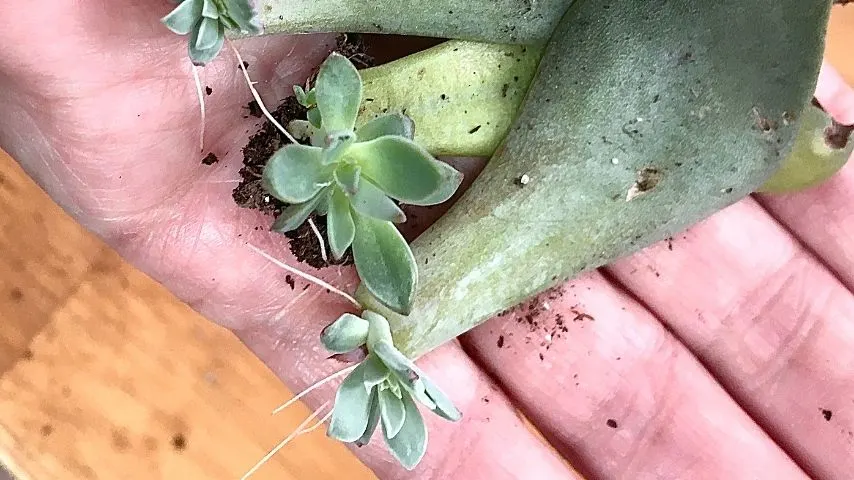
After a few weeks, tiny white roots from the Jade plant cuttings will grow
Propagating The Cuttings in Water
Follow these simple steps to propagate your Jade plant stem or leaf cuttings in water:
1. Put the base of the stem or leaf in a water-filled container. You can either have a separate container for each cutting or put a few in a large container.
However, ensure that your cuttings are not crowded to allow good air circulation. (Use clear glass containers as it’s easier to monitor the root development.)

Place the base of the Jade stem or leaf cutting in a clear container filled with water
2. Place the container in an area receiving a healthy dose of bright yet indirect sunlight.
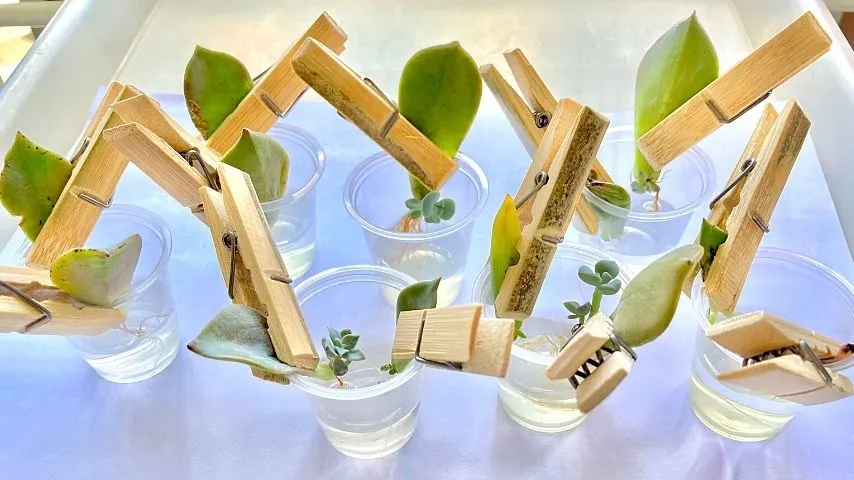
Place each of the Jade leaf or stem cutting in an area receiving bright yet indirect sunlight
3. Make sure to change the water in the container after every few days while carefully monitoring for root development. Take off any mushy or yellow cuttings.
4. Group the healthy cuttings that have developed roots and place them into planters with an organic potting mix. Water the planted cuttings regularly.
Propagating the Cuttings in Soil
Follow these simple steps to propagate your Jade plant stem or leaf cuttings in soil:
1. Take a 4 – 6 inches wide planter pot with drainage holes at its bottom part. A third of the pot should be filled with moist potting mix. The most suitable potting mix for Jade Plants is made using coco coir and perlite.
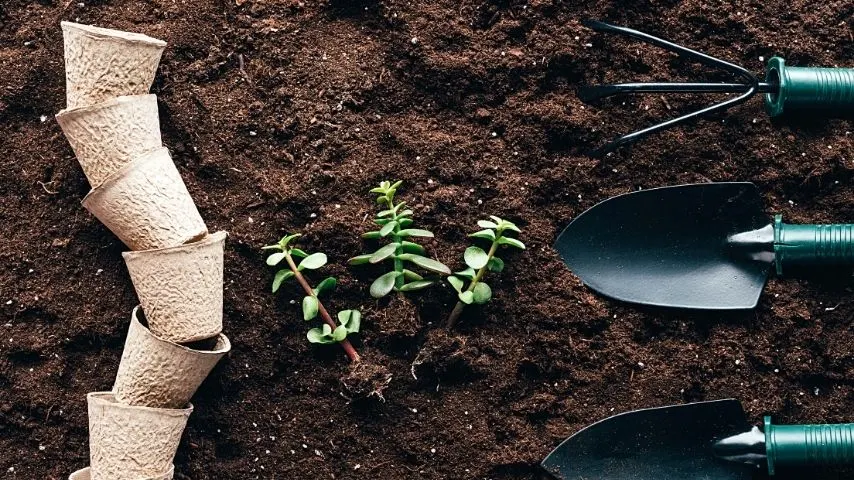
Fill one third of the 4-6 inch wide planters with moist potting mix for you to plant the cuttings in them
2. Group a few cuttings (mainly 3 cuttings for a 4-inch wide pot and 5 for a 6-inch wide planter) and place them in the pot. Let the base of these cuttings rest on the bed of your potting mix.
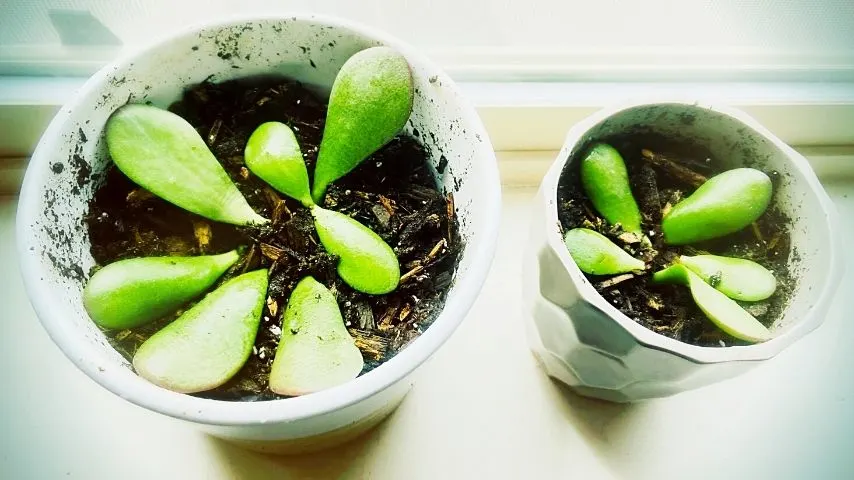
You can group together the Jade plant cuttings before placing them in the pot
3. Top the Jade plant cuttings with potting mix, leaving around 1-inch space at the planter’s top. Don’t forget to water the soil, ensuring it drains well from the pot or container.
4. Place the pot in a place receiving indirect, bright sunlight.
5. Water the cuttings regularly, mainly when you feel that the soil’s a bit dry. Jade plants grow well in slightly moist soil.
3. By Root Division
To propagate the Jade plant using the root division method, split the plant into two sections to replant them individually.
This method is best suited for mature or newly-purchased plants that don’t have many plants potted in the same container.
Generally, growers pot around 3-5 cuttings in one container to give it a fuller look. You can simply unpot it and divide it into sections to plant them separately in different pots.
Frequently Asked Questions about How to Propagate a Jade Plant
What is the best soil for Jade Plant cuttings?
A mixture of coco coir and perlite works well for jade plant cuttings. This potting soil ensures that the water drains well to prevent diseases and root rot. Succulents, including Jade plants, thrive in arid environments and can’t tolerate highly moist conditions.
How to water the Jade plant properly?
The best time to water the Jade plant is when you notice small wrinkles on the leaves. These wrinkles are a sign that your plant needs to be watered. Never overwater your jade plant, as overwatering will kill it.
Does Jade Plant need fertilizer?
Once the cuttings have matured enough after a few weeks, adding a little fertilizer will help promote the growth. A balanced fertilizer (10-10-10) will work well for Jade plants. Start by adding a small quantity of fertilizer in the beginning.

Daniel has been a plant enthusiast for over 20 years. He owns hundreds of houseplants and prepares for the chili growing seasons yearly with great anticipation. His favorite plants are plant species in the Araceae family, such as Monstera, Philodendron, and Anthurium. He also loves gardening and is growing hot peppers, tomatoes, and many more vegetables.


